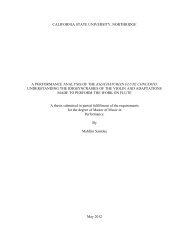2644 - CSUN ScholarWorks - California State University, Northridge
2644 - CSUN ScholarWorks - California State University, Northridge
2644 - CSUN ScholarWorks - California State University, Northridge
Create successful ePaper yourself
Turn your PDF publications into a flip-book with our unique Google optimized e-Paper software.
journal of Student Research Abstracts · 79<br />
along with the consultation from my teacher, to use euglena. I coated the bottoms of two petri dishes with samples<br />
from the euglena culture. I added "Water Joe," a caffeinated water product, to one of the dishes. "Water<br />
Joe" contained 60 grams of caffeine to 500 ml of water. Euglena are phototropic so I used a lamp to manipulate<br />
them to go to from one place to another. I used a piece of 2 x 2" black construction paper and I cut a small<br />
slit about 2 mm long and 25 mm wide near the center of the paper. The paper was placed on top of the petri<br />
dish. I hypothesized that because euglena like light and they have green pigmentation, then would form a green<br />
colored band. After a band was obtained, I moved the paper over about 5 mm and recorded the time it took for<br />
the euglena to move from one place to the other. Between the two dishes there was no noticeable difference in<br />
time for the movement of the euglena. I was able to conclude that caffeine did not have any observed effects<br />
on the euglena.<br />
2821<br />
ANGlE OF STEM GROWTH ON RADISH SEEDS INDUCED BY<br />
CENTRIFUGATION.<br />
Bruce Chien and Steve DeGusta (teacher). John F. Kennedy High School, 6715 Gloria Drive, Sacramento,<br />
CA 95831.<br />
Early scarlet globe radish seeds were grown on a record player spinning at 33.33 rpm to see the effect of<br />
centrifugation on seeds. The seeds were placed at 1.38cm (represents 0.1 G), 5.9cm (0.5 G), and at 13.8 em<br />
(1 G) from the center. The radish seeds that were placed farther from the center experienced greater centrifugal<br />
force. The radish seeds experienced vector forces of gravity at a new vector force of angle. The problem is<br />
to see if the stems of the radish seeds will grow according to the vector forces generated by the centrifugation.<br />
The equation used to find the radius for the amount of G force was r =1.41 x I0- 2 g where g is the gravitation.<br />
This tells me the amount of G force the seeds will experience at certain distance. The control was one set of<br />
seeds on the counter not spinning with the same amount of light as the experimental. After growing the seeds<br />
I measured the angle of the stems toward the center of the record and compared the resulting angle with the<br />
predicted angle of growth. The results resembled what I had expected, for the seeds experiencing 1 G to bend<br />
at 45° and 30° for 0.5 G. Most of the stems moved towards the angles that I had predicted. The differences of<br />
data in control and experimental were not due to chance (p> 0.1). I concluded that centrifugation on radish<br />
seeds does bent the stems at a predictable angle.<br />
2822<br />
EFFECTS OF CIGARETTE SMOKE ON BRINE SHRIMP.<br />
Tiffany Lieuw and Steve DeGusta (teacher). John F. Kennedy High School, 6715 Gloria Drive, Sacramento,<br />
CA 95831.<br />
In this investigation I worked with the Artemia species, more commonly known as brine shrimp. I subjected<br />
the brine shrimp to second hand smoke to see the effects of cigarette smoke on organisms. Using the top<br />
part of a 2-liter bottle, taped to an ashtray, with a syringe covering the opening of the 2-liter bottle, I inserted<br />
a lit cigarette on the side of the ashtray where there was an untapped opening. The syringe was used to collect<br />
the smoke; then I slowly injected the smoke onto a concave microslide where ten experimental brine shrimp<br />
swam. Within three minutes, some brine shrimp began to curl up, while other shrimp chased their tails in a circular<br />
motion. Other brine shrimp reacted to the cigarette smoke by rapidly twitching and beating their trunk<br />
limbs. Eighty-eight out of one hundred shrimp reacted to the smoke in the experimental group, while only<br />
twenty-one of the control group reacted. The reaction to the smoke could have been due to the lack of oxygen<br />
when the cigarette smoke was placed into the water where the brine shrimp swam. There is a highly significant<br />
difference between the brine shrimp exposed to the second hand smoke and those that were not, which<br />
could possibly be due to the smoke from the cigarette. (p :::;;0.001)













